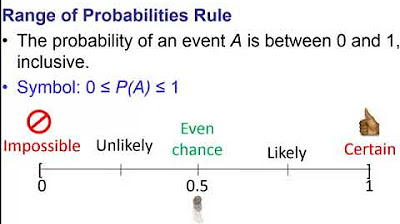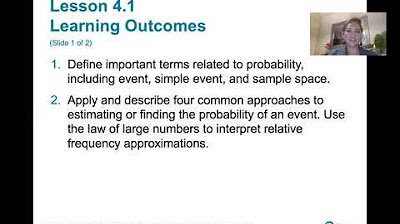Introduction to Probability, Basic Overview - Sample Space, & Tree Diagrams
TLDRThis video explains the concept of probability, focusing on defining key terms like sample space, favorable outcomes, and calculating the probability of various events. It walks through examples of tossing multiple coins, rolling dice, and drawing balls from an urn to demonstrate how to list out sample spaces, determine numbers of favorable outcomes, and divide them by total possible outcomes to calculate probabilities. The video explains that probability ranges from 0 (impossible event) to 1 (certain event) and how to interpret different probability values.
Takeaways
- 😀 Probability is calculated as number of favorable outcomes divided by total possible outcomes
- 😊 Sample space represents all possible outcomes that can occur
- 💡 Probability ranges from 0 (impossible event) to 1 (certain event)
- 📝 Can use tree diagrams to determine sample space when multiple events occur
- 🤔 Conditional probability calculates probability of one event given another event occurred
- 🧮 Contingency tables summarize relationship between two categorical variables
- 🌳 Mutually exclusive events cannot occur at the same time
- ⚖️ Independent events have no effect on each other's probabilities
- 🔢 Complementary events cover all possible outcomes between them
- 📈 Other relevant probability topics covered in stats playlist
Q & A
What is sample space in probability?
-The sample space is the set of all possible outcomes that can occur in an experiment or random trial.
How do you calculate the probability of an event occurring?
-To calculate the probability of an event occurring, take the number of favorable outcomes that lead to that event and divide it by the total number of possible outcomes.
What does a probability value of 0.3 mean?
-A probability value of 0.3 means there is a 30% chance of that event happening. Out of 10 trials, we would expect the event to occur around 3 times.
How do you construct a tree diagram for a probability experiment?
-To construct a tree diagram, start with the first step of the experiment and draw branches for each possible outcome. Then for each outcome branch, add additional branches for the subsequent step. Continue until all steps are captured.
What is meant by 'at least' one head when flipping two coins?
-When asked for the probability of 'at least one head' when flipping two coins, this includes the outcomes of getting two heads or one head and one tail. It excludes the possibility of getting two tails.
What is meant by 'exactly' one tail when flipping three coins?
-When asked for the probability of 'exactly one tail' when flipping three coins, this means getting outcomes like head-head-tail or head-tail-head. It does not include cases like all heads or all tails.
What does 'at most' 4 mean on a die roll?
-On a die roll, 'at most 4' means the outcomes 1, 2, 3, or 4. It includes getting a 4 but excludes outcomes 5 and 6.
What is the difference between sample space and favorable outcomes?
-The sample space includes all possible outcomes in an experiment. The favorable outcomes are the outcomes within the sample space that lead to the event we want to find the probability of.
What is meant by mutually exclusive and complementary events?
-Mutually exclusive events cannot happen at the same time. Complementary events cover all possibilities between them - one or the other must happen.
Where can I find more resources on probability?
-The video creator has a full probability playlist on their Youtube channel. You can also search Youtube for 'The Organic Chemistry Tutor' and topics like conditional probability.
Outlines
😀 What is Probability and Sample Space
This paragraph introduces the concept of probability (P(a)) and how to calculate it as the number of favorable outcomes divided by total possible outcomes. It also covers sample space - the set of all possible outcomes for an experiment like flipping coins. A tree diagram is used to list out sample spaces.
😃 Calculating Probability of Events with Coins
This paragraph works through examples of calculating probability for events like getting at least 1 head when flipping 2 fair coins. It also finds the probability of getting at least 2 tails or exactly 1 tail when flipping 3 fair coins using the sample space and tree diagram.
😊 Probability With a 6 Sided Die
This paragraph gives examples of finding probability with a 6 sided die. It covers finding the probability of getting a 2, getting a 3 or 5, getting a number <=4, >3, and <=5. The sample space and favorable outcomes are listed out and used to calculate each probability.
😀 More Probability and Statistics Videos
The last paragraph let's viewers know there are more probability and statistics videos available. It mentions topics like independent events, conditional probability, contingency tables, etc. and how to access more videos on the channel.
Mindmap
Keywords
💡probability
💡sample space
💡tree diagram
💡favorable outcome
💡independent events
💡conditional probability
💡mutually exclusive
💡complementary events
💡contingency table
💡statistics
Highlights
Probability is calculated as number of favorable outcomes divided by total possible outcomes
Sample space represents all possible outcomes that can occur
Tree diagrams help determine sample space when multiple events occur
Probability is always between 0 and 1
If probability is 0, event can never happen; if 1, event always happens
Probability of 0.3 means 30% chance of event occurring
Calculate probability by favorable outcomes divided by total outcomes
At least one head when flipping two coins has 75% probability
Getting at least two tails when flipping three coins has 50% probability
Exactly one tail when flipping three coins has 37.5% probability
Numbers less than or equal to 5 with six sided die has 83.3% probability
Check video description for full statistics and probability playlist
Using examples shows how to calculate probability of various events
Calculating probability is straightforward with practice on examples
Understanding sample space is key first step before probability calculations
Transcripts
Browse More Related Video

What is Probability? (GMAT/GRE/CAT/Bank PO/SSC CGL) | Don't Memorise

Chapter 4 Probability Part 1

Probability of More Complex Outcome

4.1.0 Basics of Probability - Lesson Overview, Key Concepts and Learning Outcomes

Die rolling probability | Probability and combinatorics | Precalculus | Khan Academy

Probability of Complementary Events & Sample Space
5.0 / 5 (0 votes)
Thanks for rating: